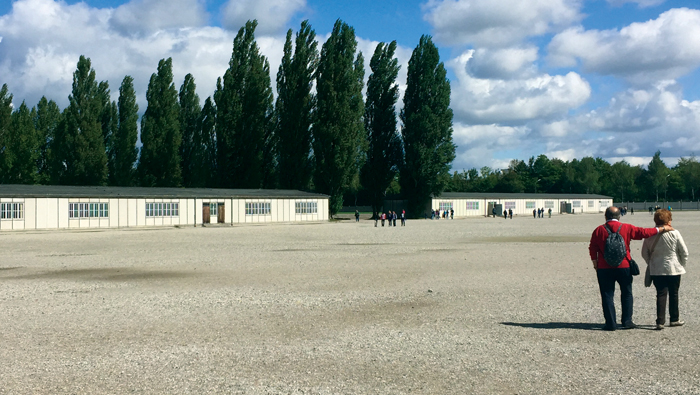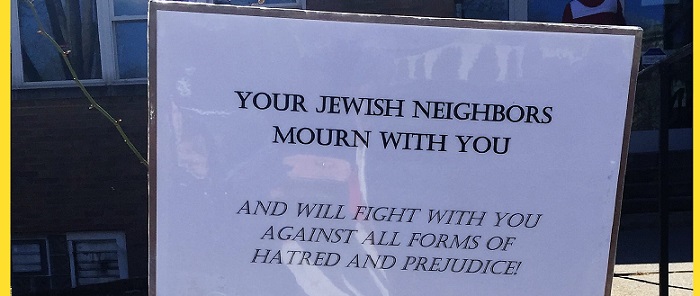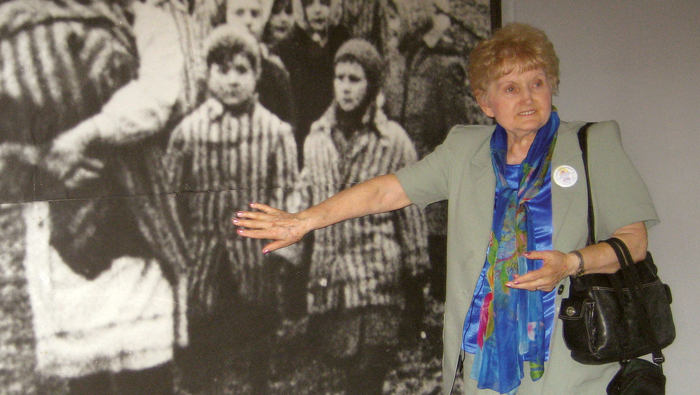
By Jenn Director Knudsen
My family last summer traveled to some of Northern Europe’s greatest cities: Amsterdam, Copenhagen, Berlin and Munich. As Dave, Alyssa (14), Hayley (12) and I planned for our trip, we reviewed maps of these cities and their environs. Dachau Concentration Camp is a one-hour drive northwest of Munich. And so it went onto our itinerary.
I maintained a blog while abroad, and I wrote about our early September, self-guided visit to Dachau. But it took me a couple of days to complete that entry; for a while I wasn’t sure I could write about it at all. Months later, we continue to ruminate about the few hours experienced there. With the approach of Yom Hashoah 2016, I reflect on them now, and know I’ll continue to do so for many Holocaust Remembrance Days to come.
Dachau Concentration Camp opened in the early 1930s. The Third Reich first used it to stow its political dissidents, and it was the first concentration camp created for the purpose of forcing prisoners to engage in hard labor. Soon it became the place known for carrying out sickening medical experiments on its Roma/Sinti, political dissident and, especially, Jewish captives.
At World War II’s end in 1945, when the horrified American liberators finally made their way to the place, nearly 42,000 people had perished, largely via starvation, typhus, freezing to death, fatal medical experiments and other horrid punishments. We learned this information – and so very much more – via our first stop inside the camp: We viewed a very emotionally jarring film narrated by an aloof broadcaster speaking the King’s English.
Dachau was the first concentration camp I’d visited. I’d previously hoped one day to be able to visit Bergen-Belsen, Theriesienstadt and Auschwitz. After our couple of hours at Dachau, however, I hope never to visit another place of such unfathomable suffering, sickness, revolting conditions, mass starvation and nightmare anecdote after nightmare anecdote – with far too many of them ending in an innocent’s death.
Having never before seen a concentration camp except as a dot on a map of the Third Reich or via pictures and films dating to World War II, I imagined Dachau located in some isolated meadow or expanse of field. Rather, Dachau is, and for hundreds of years has been, a town of regular Germans. Today its population is about 35,000, and according to one source I read, the town is trying to expand its population and its tourist attractions.
Adjacent to one of Dachau’s exterior borders is an apartment complex. How could anyone want to move there, take up residence and dwell in a place forever haunted?
At the war’s end, the townspeople were forced to enter the camp’s expansive grounds and look upon starved-to-death, piled-high bodies of Jews. It was at this point the residents knew definitively that the rumors of what was happening in their backyards – rumors made perhaps more potent by what they were smelling – were true.
In 1965, the camp became a memorial. Many of its more than 30 barracks were razed. Placed within the footprints of the excised barracks are long, rectangular tracks of millions of stones, all held in place within concrete curbing, like a graveyard.
These myriad barracks’ “footprints” are bookended on one side by a barracks now called the “Museum.” Its elongated form houses the wooden “beds” in which the prisoners “slept,” the mess hall in which they “ate,” the rooms in which medical experiments (such as with hypothermia, malaria, embolism and more) occurred, and where the prisoners relieved themselves and even attempted to shower. Originally designed to hold 50 prisoners, at the height of the war, hundreds of tortured people existed (or ceased to) in each of the barracks.
On the far end of the camp are numerous memorials: to the Jewish dead; the Catholic dead; the Soviet prisoners of war dead.
On the day we silently toured Dachau, the sky above its desolate, exposed landscape was a mixture of late-summer blue and early fall gray. A very chill wind ripped through the place. I was dressed in three layers and had my scarf fashioned like a hijab around my head to keep the bite from stinging my ears.
How did anyone physically survive this camp, which was not even one of the death camps?
Sickened to my soul, I trudged my way back to the camp entrance, to its bookstore. It seemed very strange to spend any money in a place like this (save for on the audio tour, which I don’t recommend, as the placards all around the camp are very informative and thorough), but I really wanted to own a book about the Dachau Concentration Camp’s history, use and rebirth as a paramount memorial.
I selected The Dachau Concentration Camp, 1933 to 1945, text and photo documents from the exhibition, and then perused the shelves.
Appropriately, survivors’ memoirs lined them, as did Anne Frank, Diary of a Young Girl, in about 20 languages. Academic books about the German government and the rise of Hitler in the 1930s abounded, as did Judaica – Hanukkiot, kippot, mezuzot.
How could one purchase Judaica at a concentration camp? Would its use be a triumph, signaling that on acres dedicated to the extermination of the Jewish people one can buy and enjoy a physical representation of Judaism? It didn’t seem possible; in fact, the sale of such items seemed very incongruous, almost thoughtless.
Even more incongruous were the greeting cards. At Dachau, where nearly 42,000 prisoners were murdered solely because they existed, one could purchase a Happy Birthday card.
Incredulous, I picked one off a swivel display and then quickly returned it to its slot as if it were on fire. It felt criminal to handle an object meant to denote a celebration in a hallowed place where every stone screams death.





